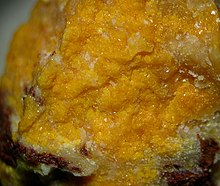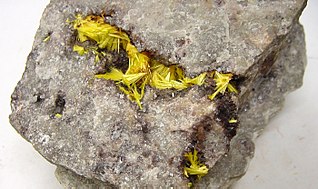
Uranophane (Ca(UO2)2(SiO3OH)2·5H2O), also known as uranotile, is a rare calcium uranium silicate hydrate mineral that forms from the oxidation of other uranium-bearing minerals. It has a yellow color and is radioactive.
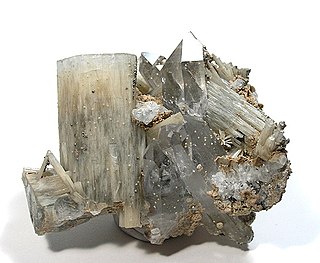
Zinnwaldite, KLiFeAl(AlSi3)O10(OH,F)2, potassium lithium iron aluminium silicate hydroxide fluoride is a silicate mineral in the mica group. The IMA status is as a series between siderophyllite (KFe2Al(Al2Si2)O10(F,OH)2) and polylithionite (KLi2AlSi4O10(F,OH)2) and not considered a valid mineral species.
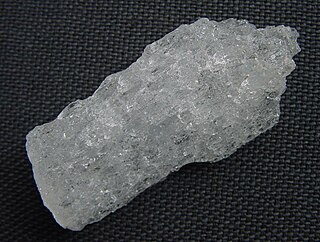
Kalinite is a mineral composed of hydrated potassium aluminium sulfate. It is a fibrous monoclinic alum, distinct from isometric potassium alum, named in 1868. Its name comes from kalium which is the Latin name for potassium, hence its chemical symbol, "K".
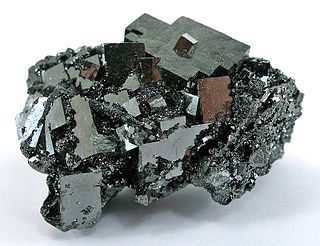
Bixbyite is a manganese iron oxide mineral with chemical formula: (Mn,Fe)2O3. The iron/manganese ratio is quite variable and many specimens have almost no iron. It is a metallic dark black with a Mohs hardness of 6.0 - 6.5. It is a somewhat rare mineral sought after by collectors as it typically forms euhedral isometric crystals exhibiting various cubes, octahedra, and dodecahedra.
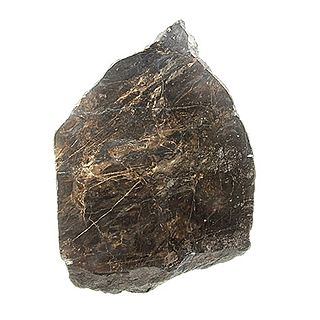
Galaxite, also known as 'mangan-spinel' is an isometric mineral belonging to the spinel group of oxides with the ideal chemical formula Mn2+Al2O4.

Jacobsite is a manganese iron oxide mineral. It is in the spinel group and forms a solid solution series with magnetite. The chemical formula is (Mn,Mg)Fe2O4 or with oxidation states and substitutions: (Mn2+,Fe2+,Mg)(Fe3+,Mn3+)2O4.

Zirconolite is a mineral, calcium zirconium titanate; formula CaZrTi2O7. Some examples of the mineral may also contain thorium, uranium, cerium, niobium and iron; the presence of thorium or uranium would make the mineral radioactive. It is black or brown in color.
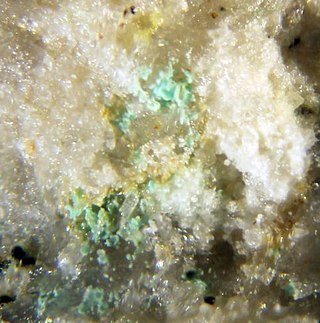
Cesbronite is a copper-tellurium oxysalt mineral with the chemical formula Cu3Te6+O4(OH)4 (IMA 17-C). It is colored green and its crystals are orthorhombic dipyramidal. Cesbronite is rated 3 on the Mohs Scale. It is named after Fabien Cesbron (born 1938), a French mineralogist.

Akatoreite ((Mn2+, Fe2+)9Al2[(OH)3|HSi4O13]) is a mineral found in New Zealand. The IMA symbol is Aka.

Stilpnomelane is a phyllosilicate mineral. It has the chemical formula K(Fe2+,Mg,Fe3+)8(Si,Al)12(O,OH)27·n(H2O).
Albrechtschraufite (IMA symbol: Asf) is a very rare complex hydrated calcium and magnesium-bearing uranyl fluoride carbonate mineral with formula Ca4Mg(UO2)2(CO3)6F2·17H2O. Its molar weight is 1,428.98 g, color yellow-green, streak white, density 2.6 g/cm3, Mohs hardness 2-3, and luster is vitreous (glassy). It is named after Albrecht Schrauf (1837–1897), Professor of Mineralogy, University of Vienna. Its type locality is Jáchymov, Jáchymov District, Krušné Hory Mountains, Karlovy Vary Region, Bohemia, Czech Republic.
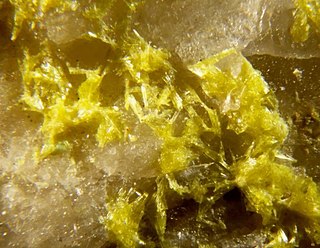
Althupite (IMA symbol: Ahp) is a rare aluminium thorium uranyl phosphate mineral with complex formula written as AlTh(UO2)7(PO4)4O2(OH)5·15H2O, from a granitic pegmatite. It is named after its composition (ALuminium, THorium, Uranium, and Phosphorus).

Wairakite is a zeolite mineral with an analcime structure but containing a calcium ion. The chemical composition is Ca8(Al16Si32O96)•16H2O. It is named for the location of its discovery in Wairakei, North Island, New Zealand, by Alfred Steiner in 1955. The first finds were in hydrothermally altered rhyolitic tuffs, ignimbrites and volcaniclastic rocks. The mineral has since been found in metamorphic rocks and in geothermal areas. It was most likely first successfully synthesized in a laboratory in 1970.

Strashimirite (IMA symbol: Ssh) is a rare monoclinic mineral containing arsenic, copper, hydrogen, and oxygen. It has the chemical formula Cu8(AsO4)4(OH)4·5(H2O).
Manganiceladonite is a rare silicate mineral with the formula KMgMn3+Si4O10(OH)2. It is one of many minerals discovered in the Cerchiara mine, La Spezia, Liguria, Italy.
Lislkirchnerite is a rare nitrate mineral with the formula Pb6Al(OH)8Cl2(NO3)5•2H2O. It was discovered in Nueva Esperanza No. 1 mine within the Capillitas deposit, Catamarca, Argentina.

Tlalocite is a rare and complex tellurate mineral with the formula Cu10Zn6(TeO4)2(TeO3)(OH)25Cl · 27 H2O. It has a Mohs hardness of 1, and a cyan color. It was named after Tlaloc, the Aztec god of rain, in allusion to the high amount of water contained within the crystal structure. It is not to be confused with quetzalcoatlite, which often looks similar in color and habit.

Afmite (IMA symbol: Afm) is phosphate mineral with the chemical formula Al3(OH)4(PO4)(PO3OH)·H2O. It is named for the French mineralogy group Association Française de Microminéralogie, or AFM for short.

Alvanite is a zinc nickel aluminum vanadate mineral with the chemical formula (Zn,Ni)Al4(V5+O3)2(OH)12·2H2O. It was originally discovered in the Karatau Mountains.
